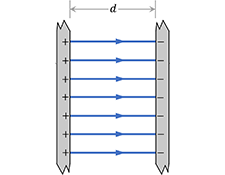
Capacitance
Variant i Interactive tutorial lecture Other Variants Dynamics first
Students examine the relationship between charge, potential difference, and electric field for parallel charged plates and are guided to construct the concept of capacitance.
Topics Electricity and magnetism / Electric circuits: proportional reasoning, capacitance, electric fields, electric potential difference, and parallel plate capacitors
Materials
Materials by the UW team
- Clicker Questions Only


- Instructor Guide


- Pretest



- Pretest for LMS



- Exam Questions



- Equipment List

Tutorial details
Section I: Parallel plates
In Questions A-B, students consider a situation with two large conducting plates with net charge $+Q$ and $–Q$ separated by a distance $d$. Students create an expression for the potential difference between the plates in terms of the quantities given, then consider the effect of moving the plates closer together.
In Questions C-D, students consider a similar series of questions for the case where the plates are instead connected across a battery.
Section II: Capacitance
Students are introduced to the ratio $\frac{Q}{\Delta V}$ and recognize that it only depends on the plate area, plate separation, and material inside. The term capacitance is then introduced.
In Question C-D, students determine how the quantities $Q$, $E$, and $C$ change when the plates are moved farther apart. They repeat this for the case where the plates are connected to a battery.
For instruction tips, login or register as a verified educator to see the Instructor Guide.
Prerequisites
Prerequisite tutorials
The Charge and Electric potential difference tutorials are prerequisites to Capacitance.
Other prerequisites
No prior knowledge of capacitors or capacitance is required.
Coming Soon! We hope to release the discussion section on each tutorial soon.

